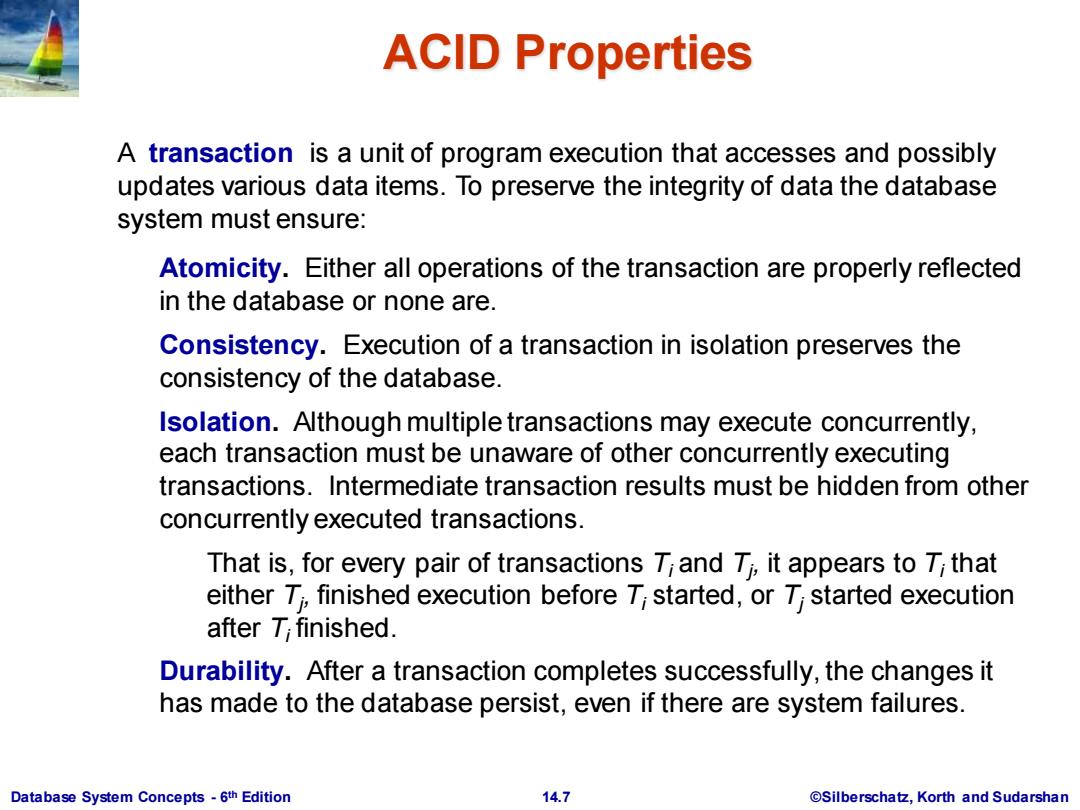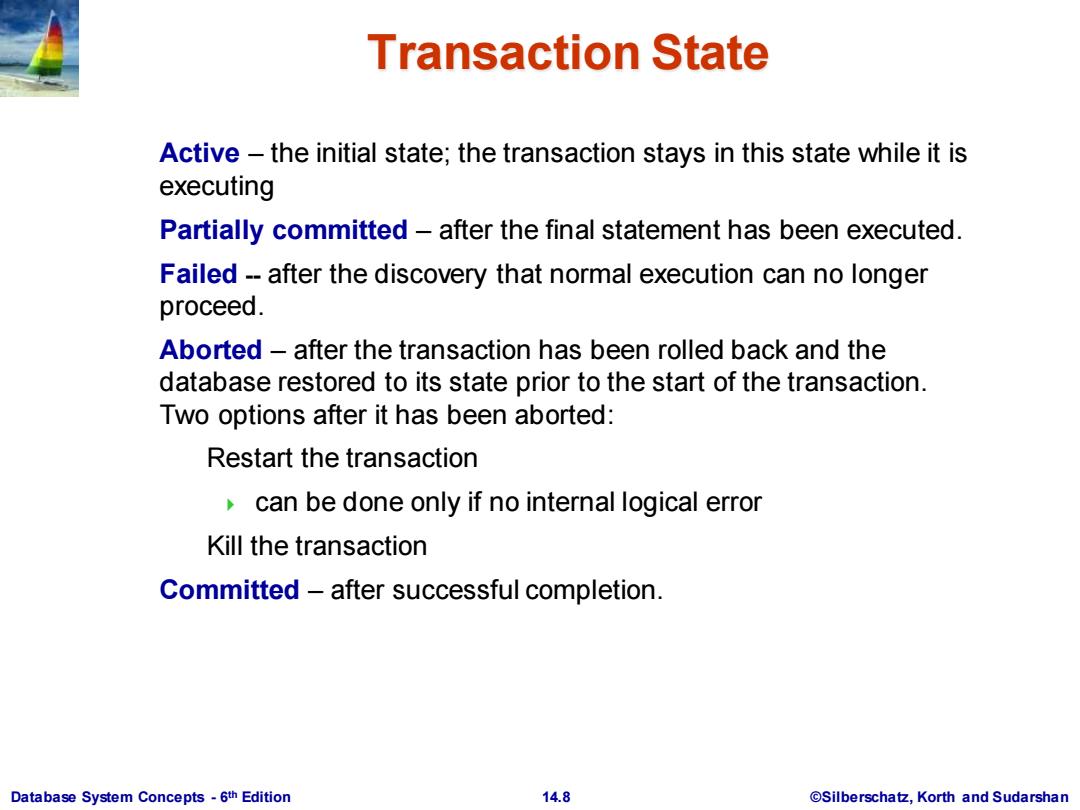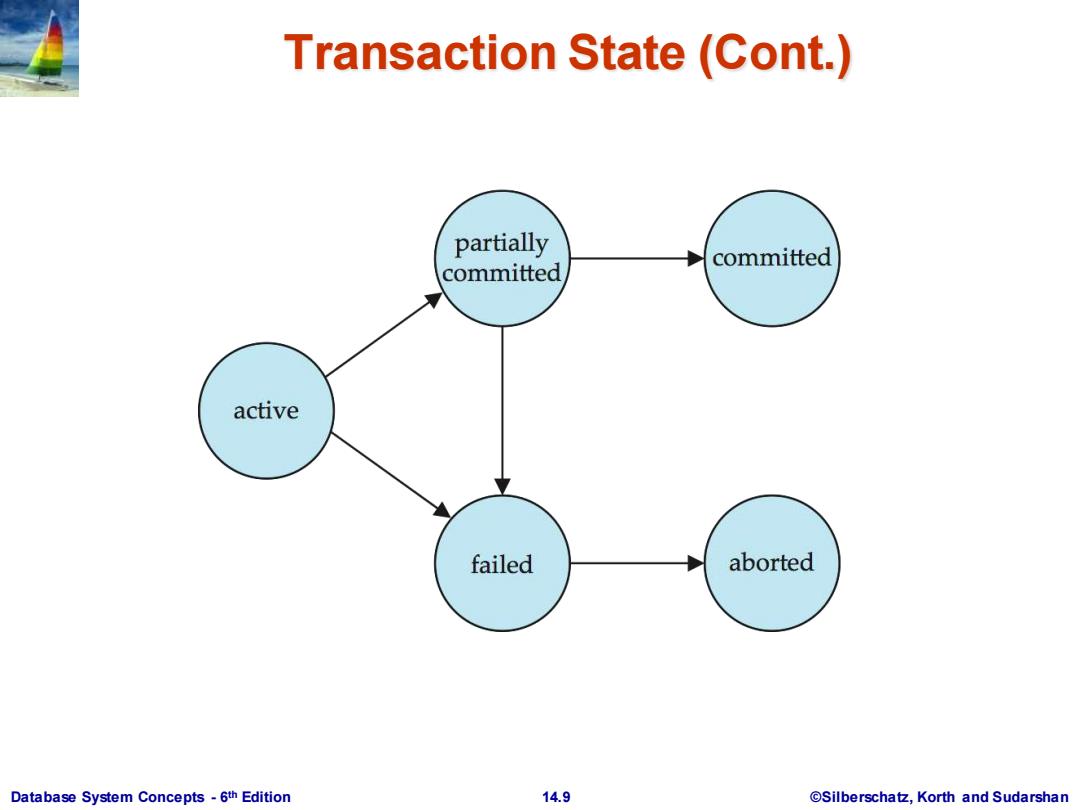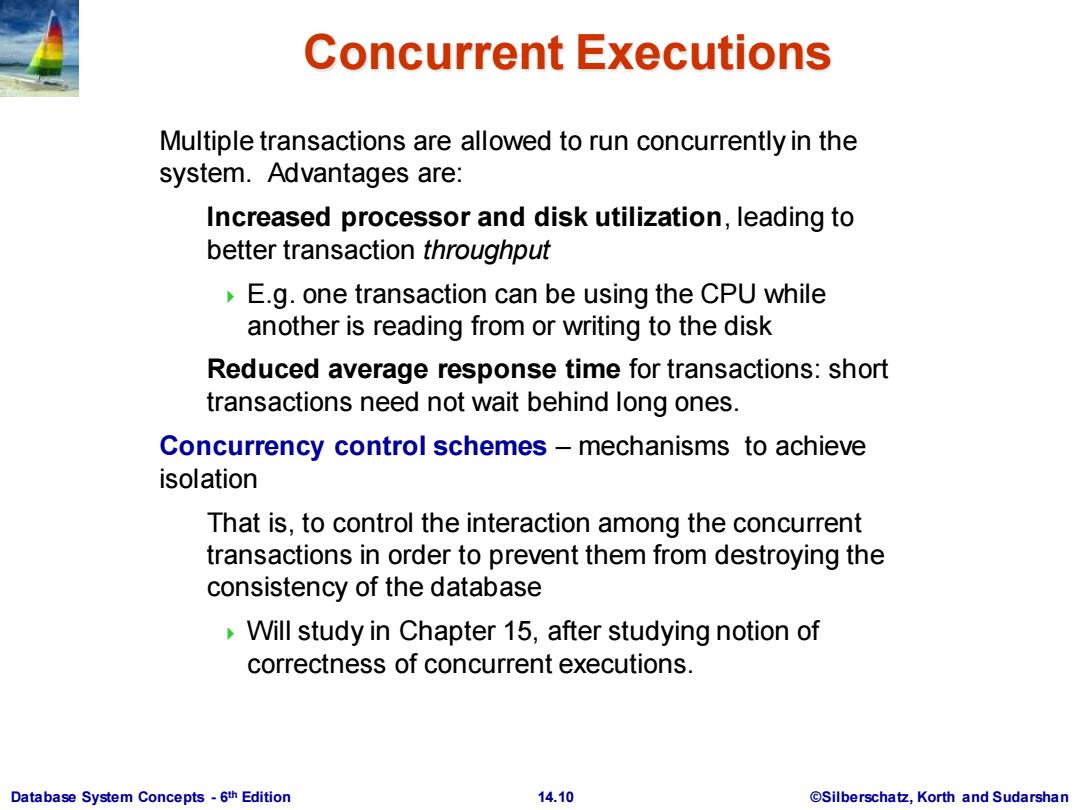
ACID Properties A transaction is a unit of program execution that accesses and possibly updates various data items.To preserve the integrity of data the database system must ensure: Atomicity.Either all operations of the transaction are properly reflected in the database or none are Consistency.Execution of a transaction in isolation preserves the consistency of the database. Isolation.Although multiple transactions may execute concurrently, each transaction must be unaware of other concurrently executing transactions.Intermediate transaction results must be hidden from other concurrently executed transactions. That is,for every pair of transactions T and Ti,it appears to T that either Ti,finished execution before T;started,or T;started execution after 7;finished. Durability.After a transaction completes successfully,the changes it has made to the database persist,even if there are system failures. Database System Concepts-6th Edition 14.7 @Silberschatz,Korth and Sudarshan
Database System Concepts - 6 14.7 ©Silberschatz, Korth and Sudarshan th Edition ACID Properties Atomicity. Either all operations of the transaction are properly reflected in the database or none are. Consistency. Execution of a transaction in isolation preserves the consistency of the database. Isolation. Although multiple transactions may execute concurrently, each transaction must be unaware of other concurrently executing transactions. Intermediate transaction results must be hidden from other concurrently executed transactions. That is, for every pair of transactions Ti and Tj , it appears to Ti that either Tj , finished execution before Ti started, or Tj started execution after Ti finished. Durability. After a transaction completes successfully, the changes it has made to the database persist, even if there are system failures. A transaction is a unit of program execution that accesses and possibly updates various data items. To preserve the integrity of data the database system must ensure:

Transaction State Active-the initial state;the transaction stays in this state while it is executing Partially committed-after the final statement has been executed. Failed--after the discovery that normal execution can no longer proceed. Aborted-after the transaction has been rolled back and the database restored to its state prior to the start of the transaction. Two options after it has been aborted: Restart the transaction can be done only if no internal logical error Kill the transaction Committed-after successful completion. Database System Concepts-6th Edition 14.8 @Silberschatz,Korth and Sudarshan
Database System Concepts - 6 14.8 ©Silberschatz, Korth and Sudarshan th Edition Transaction State Active – the initial state; the transaction stays in this state while it is executing Partially committed – after the final statement has been executed. Failed -- after the discovery that normal execution can no longer proceed. Aborted – after the transaction has been rolled back and the database restored to its state prior to the start of the transaction. Two options after it has been aborted: Restart the transaction can be done only if no internal logical error Kill the transaction Committed – after successful completion

Transaction State (Cont.) partially committed committed active failed aborted Database System Concepts-6th Edition 14.9 ©Silberscha乜,Korth and Sudarshan
Database System Concepts - 6 14.9 ©Silberschatz, Korth and Sudarshan th Edition Transaction State (Cont.)

Concurrent Executions Multiple transactions are allowed to run concurrently in the system.Advantages are: Increased processor and disk utilization,leading to better transaction throughput E.g.one transaction can be using the CPU while another is reading from or writing to the disk Reduced average response time for transactions:short transactions need not wait behind long ones. Concurrency control schemes-mechanisms to achieve isolation That is,to control the interaction among the concurrent transactions in order to prevent them from destroying the consistency of the database Will study in Chapter 15,after studying notion of correctness of concurrent executions. Database System Concepts-6th Edition 14.10 ©Silberschat乜,Korth and Sudarshan
Database System Concepts - 6 14.10 ©Silberschatz, Korth and Sudarshan th Edition Concurrent Executions Multiple transactions are allowed to run concurrently in the system. Advantages are: Increased processor and disk utilization, leading to better transaction throughput E.g. one transaction can be using the CPU while another is reading from or writing to the disk Reduced average response time for transactions: short transactions need not wait behind long ones. Concurrency control schemes – mechanisms to achieve isolation That is, to control the interaction among the concurrent transactions in order to prevent them from destroying the consistency of the database Will study in Chapter 15, after studying notion of correctness of concurrent executions

Schedules Schedule-a sequences of instructions that specify the chronological order in which instructions of concurrent transactions are executed A schedule for a set of transactions must consist of all instructions of those transactions Must preserve the order in which the instructions appear in each individual transaction. A transaction that successfully completes its execution will have a commit instructions as the last statement By default transaction assumed to execute commit instruction as its last step A transaction that fails to successfully complete its execution will have an abort instruction as the last statement Database System Concepts-6th Edition 14.11 ©Silberschat乜,Korth and Sudarshan
Database System Concepts - 6 14.11 ©Silberschatz, Korth and Sudarshan th Edition Schedules Schedule – a sequences of instructions that specify the chronological order in which instructions of concurrent transactions are executed A schedule for a set of transactions must consist of all instructions of those transactions Must preserve the order in which the instructions appear in each individual transaction. A transaction that successfully completes its execution will have a commit instructions as the last statement By default transaction assumed to execute commit instruction as its last step A transaction that fails to successfully complete its execution will have an abort instruction as the last statement